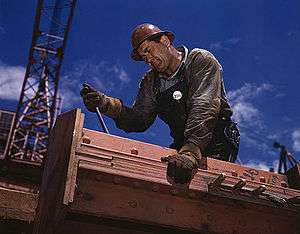Rigger (industry)

A rigger is a person who specializes in the lifting and moving of extremely large or heavy objects, often with the assistance of a crane or derrick or chain hoists.
Etymology
The term comes from the days of sailing ships, when a rigger was a person who worked with rigging, that is, ropes for hoisting the sails. Sailors could put their rope skills to work in lifting and hauling. In an era before mechanical haulage and cranes, ropes, pulleys and muscle power were all that was available to move heavy objects. In time, rigging became a trade in itself, giving rise to modern usages, with its roots all but forgotten.
Description
Riggers attach loads of equipment to cranes or structures using shackles, cables, chains, clamps or straps, employing pulleys, winches, lifts or chain hoists (aka chain motors). Quick load calculations are necessary for each load and engineering principles are always in play. Riggers use various suspension techniques to get their load around obstacles on a construction site or loading dock or event site to the desired location and height.[1]
See also
- World's Toughest Fixes, an American reality-TV series with a focus on industrial rigging
References
- ↑ Florida, Group 5 Advertising, Gainesville. "Craft Professions: Find out more about the careers available in construction - Build Your Future | Careers in Construction". byf.org. Retrieved 2016-05-03.
External links
- Specialized Carriers and Riggers Association
- What is a Rigger? - Rigger.com, by Toolwell
- Subpart CC – Cranes and Derricks in Construction: Qualified Rigger - OSHA - 2010